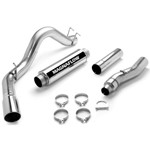Installer's Guide for Replacing Catalytic Converters
Custom Fit

When to Replace a Catalytic Converter
The vehicle has no converter. A state or local inspection determines that the existing converter is damaged and the manufacturer would not be liable. Reasons for this replacement can vary widely, including but not limited to: lead poisoning, excess fuel in the exhaust system, a malfunctioning oxygen sensor, or road damage. If an inspection reveals that the converter has been damaged, and it is under the OEM manufacturer's warranty, the manufacturer should replace it. Consult the vehicle manual or warranty booklet, or contact the vehicle manufacturer to determine the warranty. Typical warranties are from seven years and/or 70,000 miles to 15 years and/or 150,000 miles.
EPA Requirements
The converter must be installed in the same location as the original converter. It must be the same type as the original converter (that is, two-way, three-way, etc). It must be the correct converter model for the vehicle application, determined and specified by the manufacturer. It must be properly connected to any air injection tubes on the vehicle. The location, position, or orientation of any oxygen sensors must not be altered as a result of the installation. It must be installed with any other required converter for a particular application. Converters must not be consolidated, and no extra converters can be added. The warranty card must be signed and returned to the manufacturer.
Find the Correct Replacement Catalytic Converter
Departments
Towing
- Trailer Hitch
- Fifth Wheel
- Gooseneck
- Towing a Vehicle
- Front Hitch
- RV Hitch
- ATV Hitch
- HD Truck Hitch
- Vehicle Wiring
- Brake Controller
- Ball Mounts
- Weight Distribution
Sports and Recreation
Trailer Parts
- Utility Trailer
- Boat Trailer
- Landscape Trailer
- Enclosed Trailer
- 5th/Camper Trailer
- Car Hauler
- Horse Trailer
Vehicle
Contact & Help

What our customers are saying:
"Quick processing, and delivery. reasonably priced very satisfied"
Bernie
Krakow, WI
Popular Vehicles
- Subaru Forester
- Ford F-350 Super Duty
- Ford F-250 Super Duty
- Chevrolet Silverado 1500
- Jeep Wrangler Unlimited
- Jeep Wrangler
- Ram 3500
- Toyota Highlander
- Ram 2500
- Chevrolet Silverado 2500
- Subaru Outback Wagon
- Chevrolet Silverado
- Dodge Ram Pickup
- GMC Sierra 2500
- Ram 1500
- Ford F-250 and F-350 Super Duty
- Jeep Grand Cherokee
- Toyota Tacoma
- GMC Sierra 3500
- Toyota Tundra
- Ford Escape
- More >>

